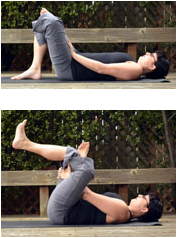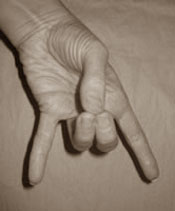|
7/24/2013 Hip OpeningTight hips are a common problem for our Western bodies. I am convince that the backs on our chairs and couches greatly contribute to our slouching posture which creates aching backs and rigid pelvises (or is that pelvi?). Anyway, this week we devote our time on the mat to opening up the hips from all angles, not just the typical "thread the needle" direction, although we will explore that as well!  Sit with Knees Below Hips In order to create space for the vertebrae and reduce slouching, when sitting cross-legged be sure to use enough height under your sit bones that your knees are below the height of your hip bones. This should be much more comfortable than without the support.  Maha Sacral Mudra Touch tips of thumbs and little fingers together, then touch the thumbs, little, and ring finger tips of both hands together; extend index and middle fingers, pointing fingers downward in front of lower abdomen. Benefits: Activates breath in the pelvis, aids digestion and emotional processing Practice Tips: Use to feel calm and grounded, also helps to process emotions Contraindications: Pregnancy  Thread the Needle Lie on the back with the knees bent. Cross your right foot over the left knee and flex the right ankle. Variation I: If you are very tight, gently press the upper inner thigh away from your belly. Variation II: If you are a bit more flexible, draw the legs to the chest and clasp the hands behind the left thigh (right hand between legs, left hand on outside of left leg). Hold 10-20 breaths then release and change sides. Therapeutics: Opens the outer hips and provides traction to the lower back. Gentle Quad Stretch on Belly Lie on belly with legs straight out behind you, toes pointed. Rest on forearms with hands clasped keeping head in line with the rest of the spine. As you inhale, bend the right knee lifting the right foot and turn the head to the left, exhale back to center. Inhale bend left knee lifting left foot and turn head to right, exhale return to center. Repeat 5-10 times per side Contraindications: If the lower back is tender, just move the legs without turning the head. Benefits: Stretches quadriceps and the connective tissue around the sacrum. Block Supta Padangusthasana I & II Part I: Lie on back with knees bent and feet on floor. Raise hips up and place block under sacrum. Bring right knee into chest and wrap strap around ball of foot. Keep left foot on floor with that knee bent as you extend the right leg so that the heel is aligned with the right sit bone. Relax head and shoulders into mat and hold for a minute or so Part II: Take both ends of strap in left hand and keeping the right leg straight move the right leg to the left 6-8 inches to stretch outer thigh. Hold for a minute or so then relax knee into chest and return right foot to the floor. Repeat to other side Benefits: Stretches back and outside of hip Supta Baddha Konasana (Reclining Bound Angle Pose or Queen's Pose)
Sit in front of two long-fold blankets or a bolster parallel to mat. Place soles of feet together and let knees move apart resting on blocks or bolster. Place looped strap around back of pelvis between thighs and over outside edge of feet to help lengthen low back. Lie back over bolster and place blanket under head. Rest 5-15 minutes, then release Therapeutics: Relaxes floor of pelvis, opens belly and chest, creates a sense of safety and calm
2 Comments
7/19/2013 Getting Digestion MovingFrom a yogic perspective, constipation can result from an over-abundance of earth element in the body, a lack of the water element, a lack of movement, and the digestive fire not burning hot enough to properly metabolize food. From an energetic and emotional perspective, hypodigestion means we are unable to process and let go of conversations, thoughts, memories, and situations. As we hold on deeply to our past, the body follows suit and undigested matter stays stagnant in the body. This week we continue our exploration of digestive health with simple proven techniques to get things moving again.  Apana Mudra Touch tips of thumb, middle and ring fingers together, extend index and little fingers; rest back of hands on thighs. Benefits: Eliminates toxins from the body, creates a sense of calm Practice Tips: Use when you need to feel safe and tranquil Contraindications: Low blood pressure  Moving Apanasana Begin lying on the back with the legs extended. Exhale draw right knees into chest and clasp the hands around shin. Exhale draw left knee into chest. Inhale return to arms overhead and legs extended. Repeat pattern with the breath for up to 3 minutes. Therapeutics: Specifically good for constipation as this awakens the intestinal peristalsis.  Ganeshasana (Elephant Pose) Begin standing with feet slightly wider than hips distance apart. Keeping the knees soft, begin to swing arms around the body like two elephant trunks, lightly tap the body with the hands wherever they land as you twist right and left. Go faster or slower depending on how it feels to you for about 1 minute. Then slow down the swinging until you are again standing still. Benefits: Increases circulation of blood and lymph throughout the body, awakens the energy and detoxifies the abdominal organs. Belly Bolster
Lie on the belly with a rolled up hand towel under the lower abdomen, right above the pubic bone. Place the forehead on the stacked hands with the elbows out to the sides. Rest in this position for up to 5 minutes directing the breath into the lower back and belly. 7/8/2013 Calming DigestionUpset stomach can be caused by a host of everyday occurrences; from over indulgence in food or drink, certain medications and even stress. Any of these can cause acid indigestion, ulcers and diarrhea. If we look at hyperdigestion from an energetic and emotional perspective, often times we are unable to 'sit with' our current struggles and situations and this creates a sense of wanting to rush through and ignore difficult situations by focusing on the many distractions outside rather than what we are truly thinking and feeling. This week we will focus on practices that cool and calm the digestive system.  Adho Merudanda Mudra Make a fist and extend thumb up, keeping gentle pressure of fingernails against palm. Rest hands on thighs palms down. Benefits: Activates prana in the pelvis and low back Practice Tips: Use when feeling depressed, or have digestive issues Setu Bandha (Bridge Pose) Lie on back with knees bent and feet hips with apart. Inhale and lift hips away from floor, place block under pelvis and rest arms on floor. Hold up to 3 minutes. Sitali or Sitakari Curl right and left sides of tongue to form a tubular shape. Slowly draw air through tongue and feel cooling sensation of air passing through throat into lungs. Close mouth and exhale through nostrils sensing movement of warm air out of body. If you cannot curl the tongue, breathe in through closed teeth and open lips. Benefits: Activates parasympathetic nervous system, reduces blood pressure, helpful for insomnia, reduces heat in body Supported Seated Forward Bend Sit cross-legged on folded blanket in front of a chair. Place bolster vertically against front of body and lean forward into bolster and chair. Turn head to side and rest for 5-10 minutes. Benefits: Gently tractions spine and places gentle support on abdominal organs. Flapping Fish Pose
Lie on belly with forehead supported by stacked palms. Draw right knee up towards arms and rest inner knee and foot on floor. Angle the upper body toward the right so that the right elbow reaches downward toward the right knee. Rest on each side for up to 5 minutes. Benefits: Gently stretches and intestines providing gentle relief from digestive complaints |
Index:Archives:
September 2022
I attend Cheryl's class regularly and feel that my practice has improved immensely over the past few years due to her expert coaching. Her teaching style is clear and compassionate and her previous experience in teaching adults is evident in her organized approach and easy to understand instructions. I also appreciate that Cheryl not only teaches us about how to correctly position ourselves, but also touches on many aspects of yoga philosophy, which in turn has deepened my personal practice and heightened my awareness of the connection between mind and body, breath and relaxation. |

 RSS Feed
RSS Feed
